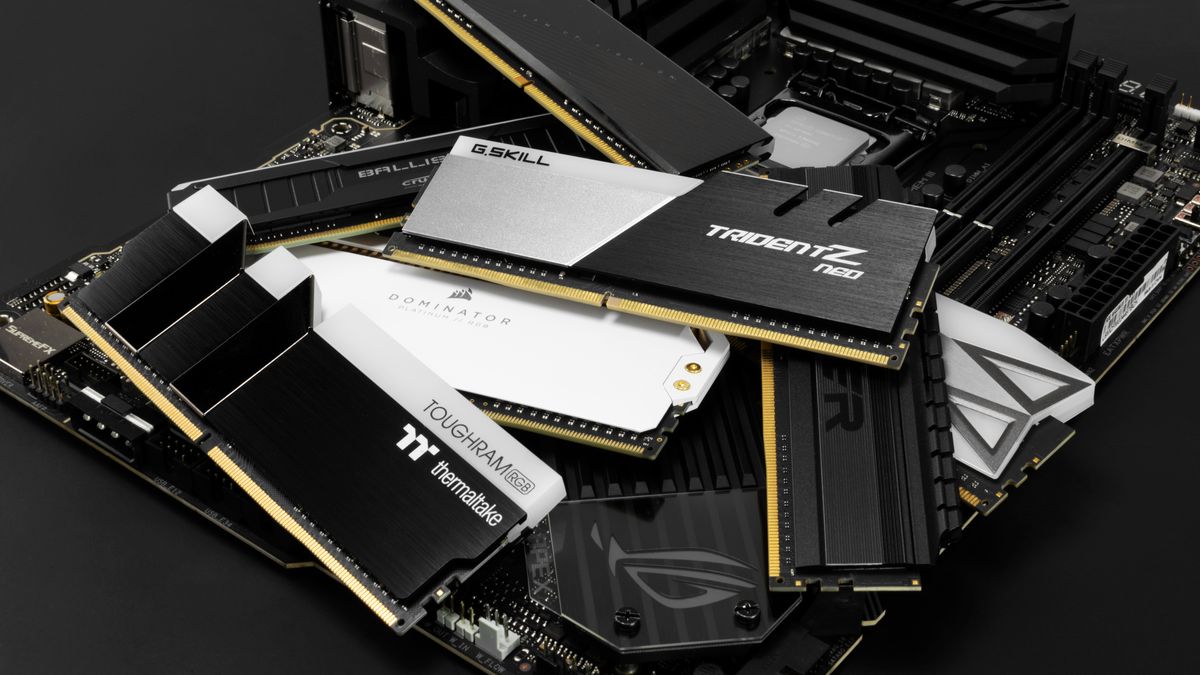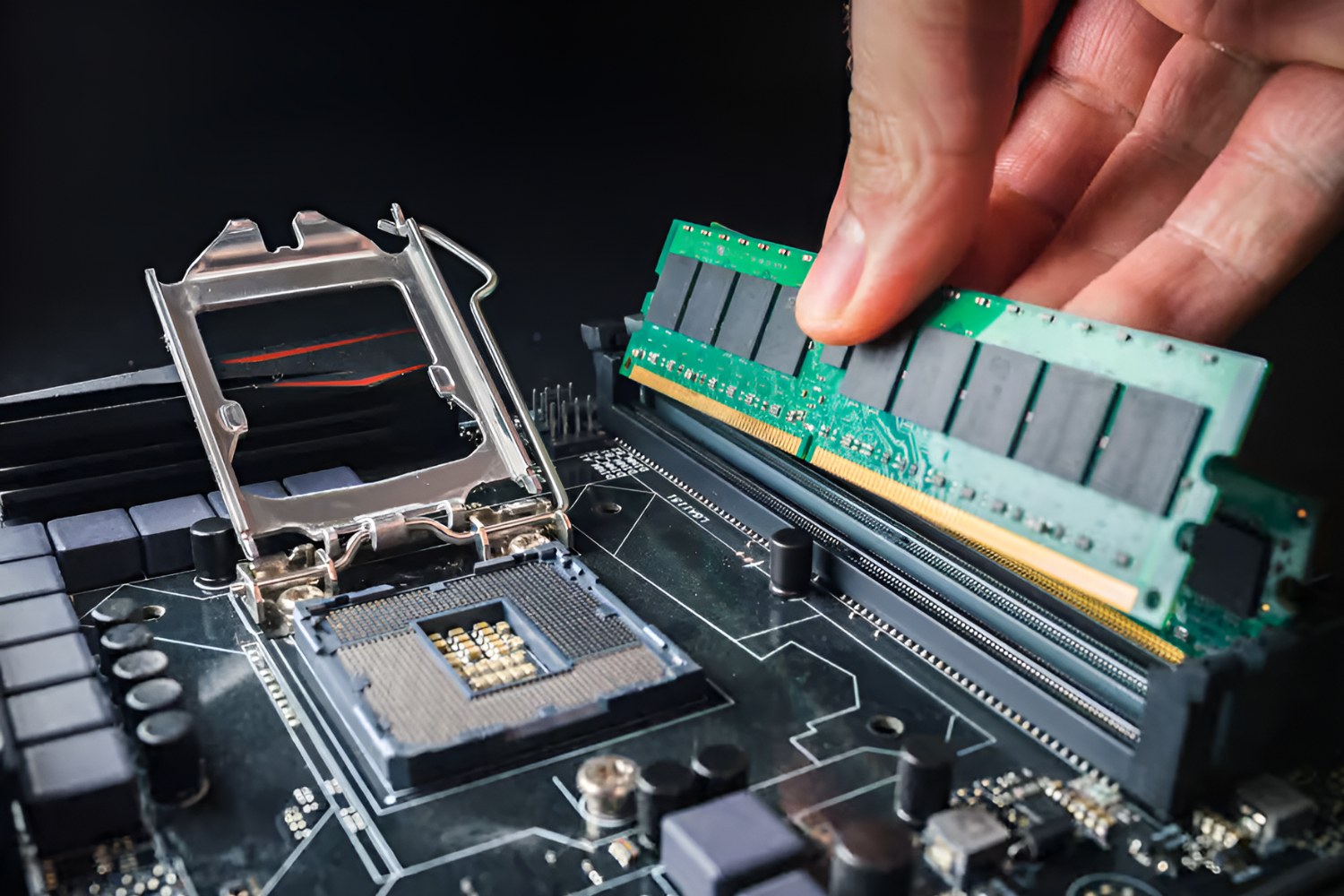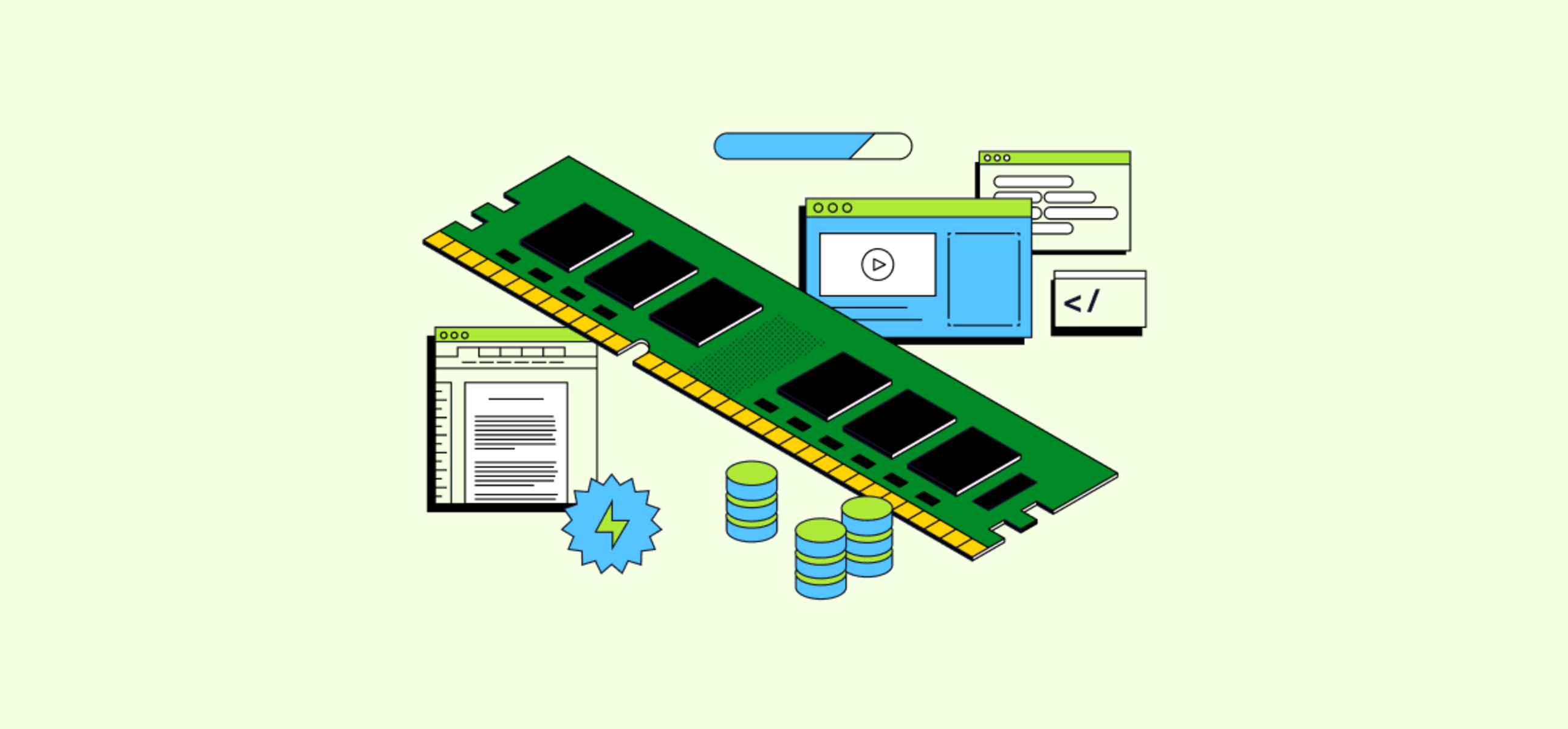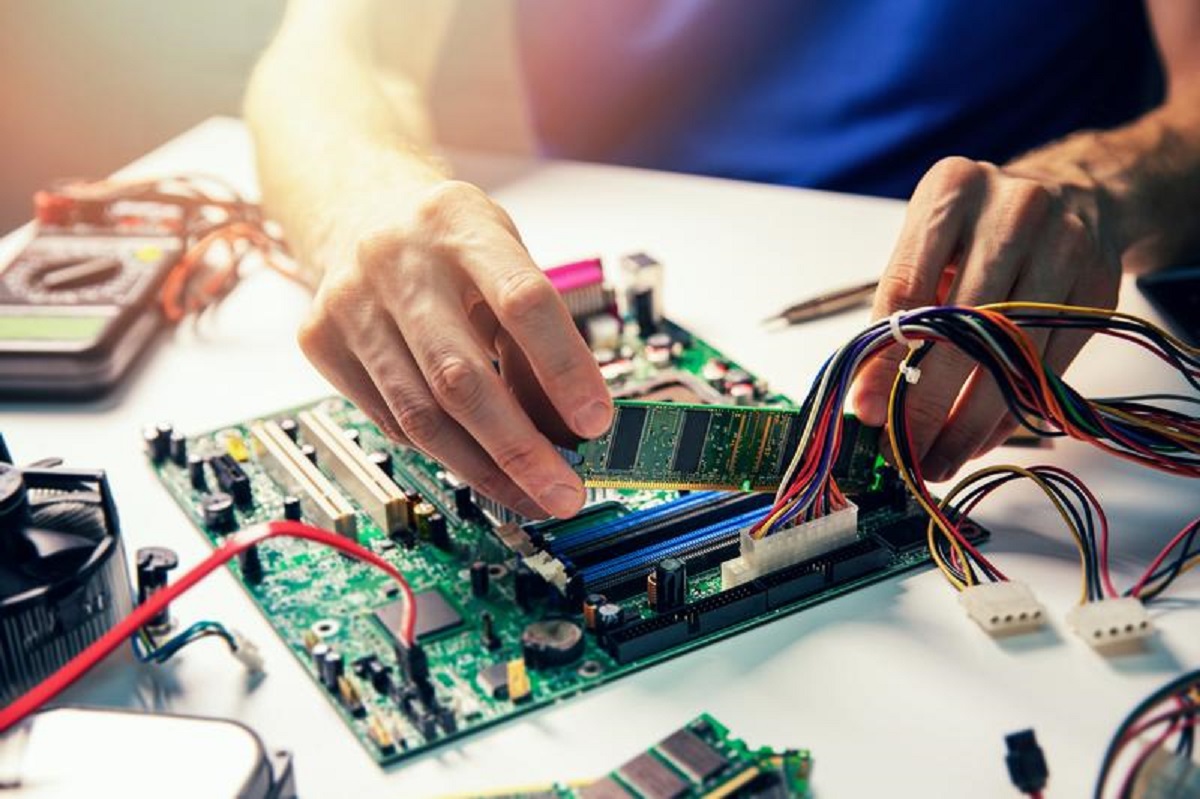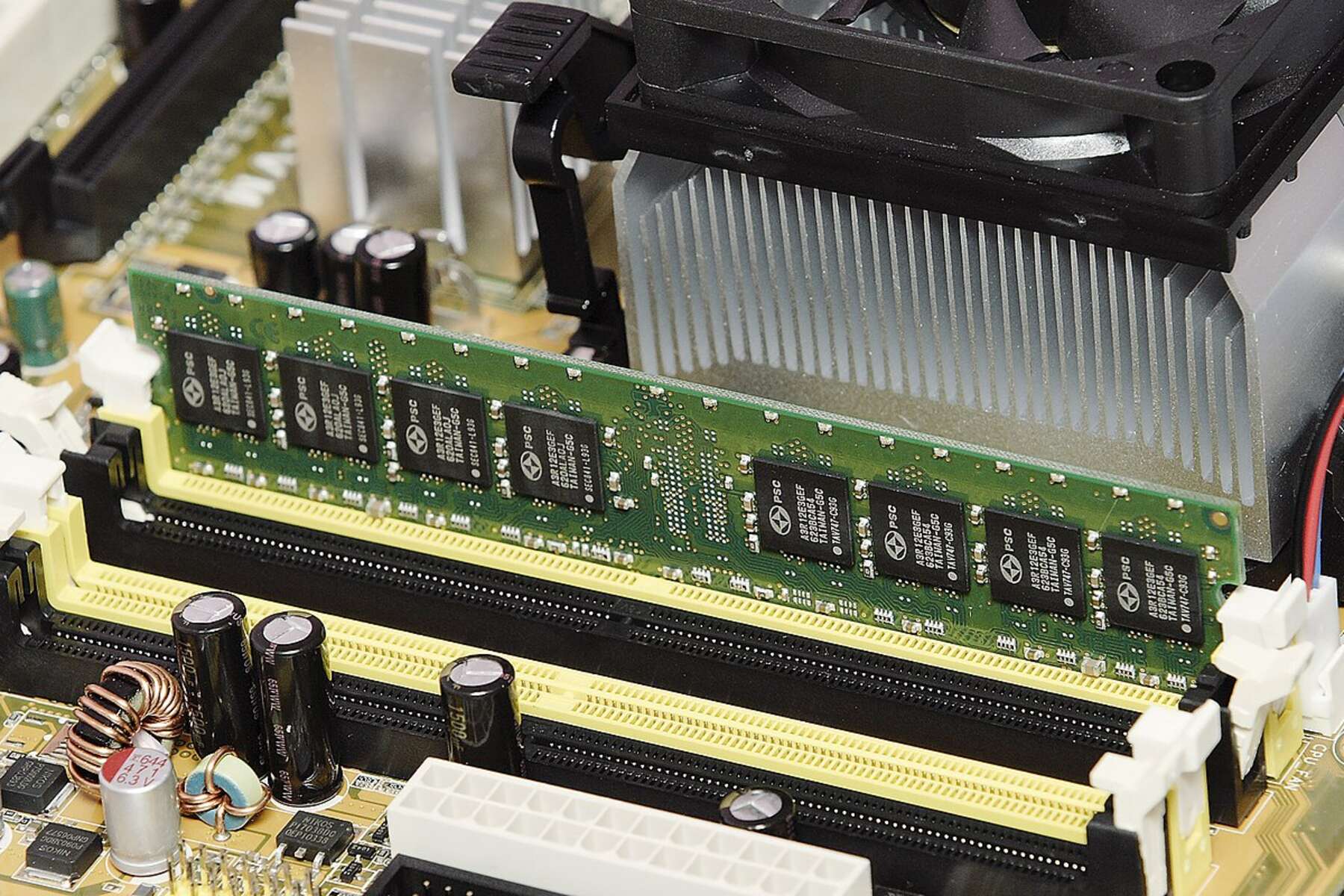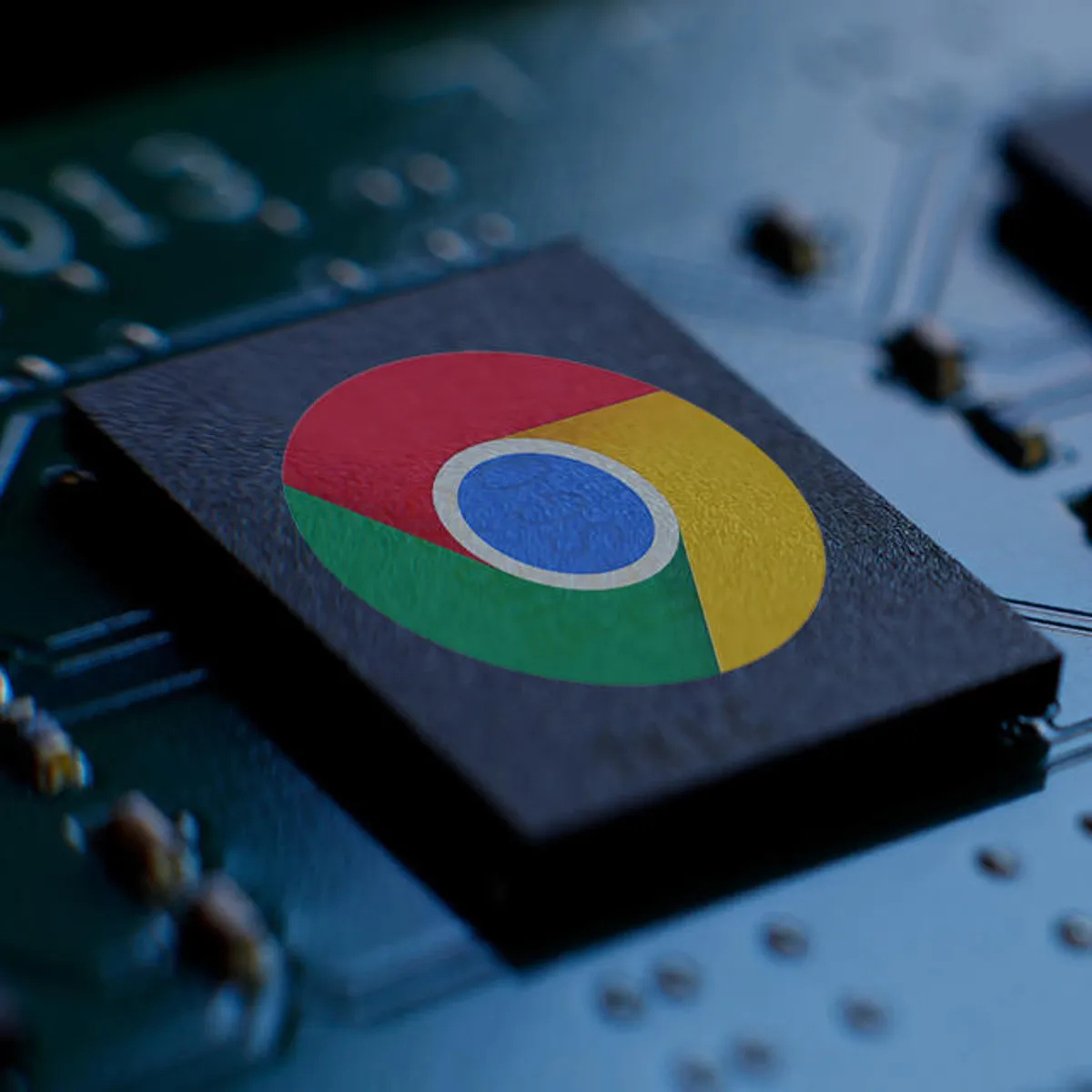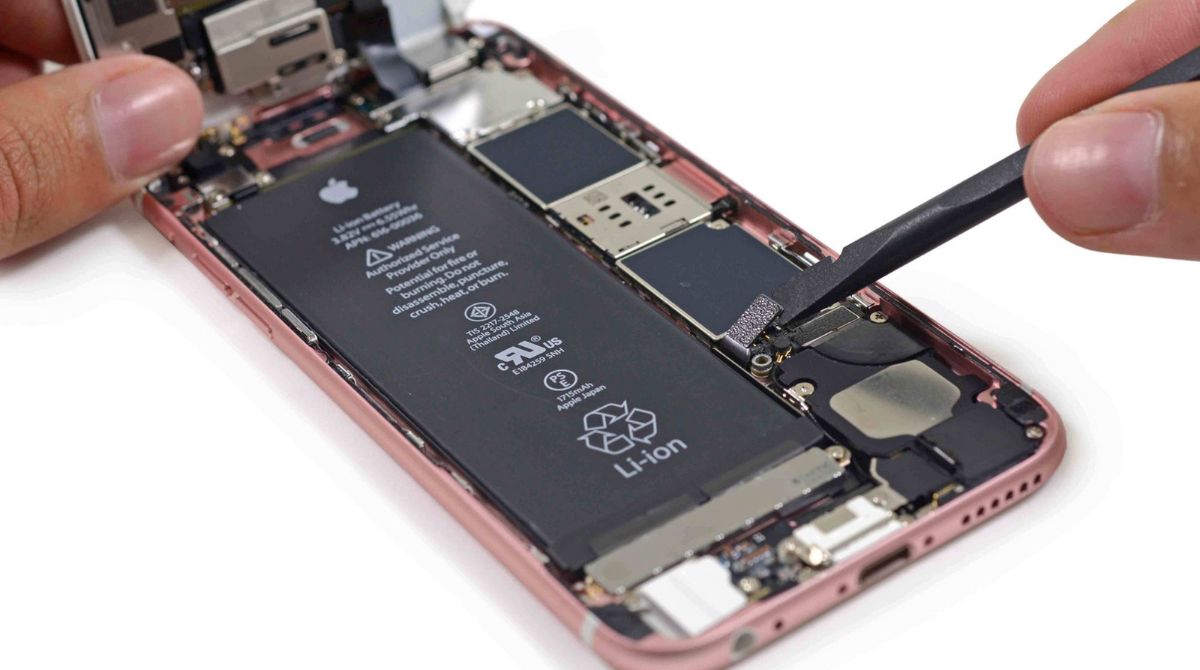What is RAM?
Random Access Memory, better known as RAM, is a crucial component of a computer system. It is a hardware device that stores data temporarily to allow quick and easy access for the processor. Unlike the permanent storage provided by a hard drive or solid-state drive (SSD), RAM provides volatile storage that is cleared when the computer is restarted or powered off.
RAM can be thought of as the computer’s short-term memory. Any data that the computer needs to access or manipulate in real-time is stored in RAM. This includes the operating system, applications, and active files. When you open a program or file, it is loaded into RAM for faster processing.
RAM is made up of small memory cells that can be read from and written to by the processor. Each memory cell has a unique address, allowing the processor to locate specific data quickly. These cells are organized into a series of memory modules that fit into slots on the computer’s motherboard. The amount of RAM a computer has is typically measured in gigabytes (GB).
One important feature of RAM is its speed. The speed at which data can be read from and written to RAM affects the overall performance of a computer system. Faster RAM allows for quicker data access and manipulation, leading to smoother multitasking and faster program execution.
It is worth mentioning that there are different types of RAM, such as DDR4, DDR3, and DDR2. The DDR4 RAM, being the latest standard, provides faster and more efficient data transfer compared to its predecessors. However, the type of RAM supported by a computer is determined by its motherboard and processor compatibility.
In summary, RAM is a vital component of a computer system as it provides temporary storage that facilitates quick and efficient access to data. Its speed and capacity play a key role in determining the performance and responsiveness of a computer. Understanding the role and importance of RAM is essential when it comes to making informed decisions about computer upgrades or purchasing a new system.
How does RAM work?
RAM, or Random Access Memory, is a critical component in a computer system that enables the efficient and rapid access of data by the processor. Understanding how RAM works can shed light on its importance in optimizing computer performance.
RAM functions as a temporary storage area that holds data that the computer needs to access quickly. When you open a program or file, it is loaded onto the RAM for faster processing. The data stored in RAM can be read from and written to by the processor, making it readily available for computational tasks.
Rather than storing data magnetically, like a traditional hard drive, RAM stores data electronically. It consists of millions of memory cells, each capable of holding a single piece of data. These memory cells are organized in a grid-like structure and are composed of transistors and capacitors. The capacitors within each memory cell can hold a specific charge, representing a binary value of 0 or 1.
When the computer needs to access specific data, the processor sends a request to the RAM controller, which then locates the memory cell containing the requested data and retrieves it. The data is then sent to the processor for execution. The read and write operations in RAM happen at lightning speed, allowing for quick retrieval and modification of data.
One crucial aspect of RAM is its volatility. Unlike permanent storage, like hard drives, RAM is a volatile memory. This means that the data stored in RAM is lost when the computer is powered off or restarted. To ensure that important data is not lost, it is essential to save files to a permanent storage device such as a hard drive or SSD.
Furthermore, the speed at which RAM operates is crucial for optimal system performance. Higher-speed RAM modules allow for faster data transfer and retrieval, reducing lag times and improving overall responsiveness. However, it is important to note that the speed of RAM is dependent on both the RAM modules themselves and the computer’s motherboard and processor compatibility.
In summary, RAM acts as a temporary storage area that enables quick access to data by the processor. Its volatile nature and electronic storage mechanism make it an essential component for optimizing computer performance. Understanding how RAM works can assist in making informed decisions when upgrading or choosing a new computer system.
The role of RAM in a computer system
Random Access Memory, commonly known as RAM, plays a crucial role in the overall performance and functionality of a computer system. It serves as a temporary storage location that allows the processor to quickly access and manipulate data needed for various tasks. Understanding the role of RAM can help us comprehend its significance in a computer system.
One primary function of RAM is to store the actively running programs and data that are currently in use. When you open an application or file, it is loaded into RAM to enable faster access and processing by the processor. This ensures that the computer can quickly and efficiently retrieve the necessary data without relying solely on slower permanent storage devices like hard drives or SSDs.
RAM works hand in hand with the processor and the operating system to facilitate seamless multitasking. As you run multiple programs simultaneously, each program requires a certain amount of RAM to hold its code and data. With sufficient RAM, the computer can switch between different applications and tasks efficiently, without experiencing significant slowdowns or performance issues.
In addition, RAM plays a critical role in improving overall system performance and responsiveness. The more RAM a computer has, the more data it can store and access quickly. This allows for faster calculations, smoother graphics rendering, and reduced loading times. Whether you’re editing large files, playing graphics-intensive games, or running resource-intensive applications, having an adequate amount of RAM is essential for a seamless user experience.
Furthermore, RAM also serves as a buffer between the processor and the storage devices. When you access files or run programs, they are temporarily stored in RAM for quicker access. This minimizes latency and reduces the need for the processor to constantly access slower storage devices. As a result, the overall system performance is improved, and tasks are executed with greater efficiency.
It is important to note that the amount of RAM in a computer system is not the only factor that determines its performance. Factors such as the type and speed of RAM, the processor, and the graphics card also play a significant role. Hence, it is crucial to ensure a balance between these components to maximize the benefits of RAM.
In summary, RAM plays a vital role in a computer system by providing temporary storage for actively running programs and data. It contributes to multitasking capabilities, improves system performance, and reduces reliance on slower storage devices. Understanding the role of RAM helps in optimizing computer systems and ensuring a smooth and efficient user experience.
Why is RAM important for performance?
Random Access Memory (RAM) plays a crucial role in determining the overall performance and responsiveness of a computer system. It acts as a bridge between the processor and the storage devices, providing temporary storage for data that the processor needs to access quickly. There are several reasons why RAM is critically important for enhancing system performance.
First and foremost, RAM allows for faster access to data. When you open a program or file, it is loaded into RAM, enabling the processor to access and manipulate the data at a much higher speed compared to accessing it from a hard drive or SSD. This significantly reduces the latency or delay in data retrieval, resulting in accelerated program execution and seamless multitasking.
RAM also plays a crucial role in enabling efficient multitasking capabilities. With sufficient RAM, your computer can handle multiple applications and tasks simultaneously without experiencing a significant decline in performance. Each program requires a certain amount of RAM to store its code and data while it is running. Insufficient RAM can lead to slow performance, longer program loading times, and frequent freezing or crashes.
Additionally, more RAM allows for the caching of frequently accessed data and instructions. When you revisit a website or open a frequently used application, the computer can store a copy of the data in RAM for quicker retrieval. This caching mechanism reduces the need to retrieve the data from slower storage devices every time, resulting in faster load times and improved overall system performance.
RAM is also crucial for optimizing gaming experiences and graphics-intensive tasks. Many modern games and resource-intensive applications require a significant amount of RAM to store and process graphics data. Inadequate RAM can lead to lower frame rates, graphical glitches, and overall poor gaming performance. Having ample RAM ensures smooth gameplay and enhances the visual quality of graphics-intensive applications.
Another important aspect is that RAM helps prevent excessive usage of virtual memory. When the computer runs out of physical RAM, it starts utilizing a portion of the hard drive or SSD as virtual memory. However, accessing data from virtual memory is significantly slower than accessing data from RAM. Excessive reliance on virtual memory can lead to a noticeable decline in system performance. Having enough RAM ensures that the computer can operate primarily on physical memory, reducing the need for frequent access to slower storage devices.
In summary, RAM is essential for optimizing overall system performance. It enables faster access to data, enhances multitasking capabilities, improves gaming experiences, reduces reliance on virtual memory, and accelerates program execution. Ensuring an adequate amount of RAM is crucial for experiencing a smooth and responsive computer system.
How much RAM do you need?
The amount of RAM you need for your computer depends on several factors, including the intended usage, the operating system, and the specific requirements of the software you plan to run. While there is no one-size-fits-all answer to this question, understanding some general guidelines can help you determine the appropriate amount of RAM for your needs.
For basic tasks such as web browsing, email, and word processing, 4GB to 8GB of RAM is typically sufficient. This amount of RAM allows the computer to run these applications smoothly and handle everyday tasks without any noticeable slowdowns.
If you frequently use resource-intensive applications such as photo editing software, video editing software, or 3D modeling software, you will benefit from having more RAM. In this case, 16GB to 32GB or even higher may be recommended. These applications require a significant amount of memory to store and process large files and complex operations, and having ample RAM will ensure smooth and efficient performance.
Gaming enthusiasts often require high amounts of RAM to handle the demands of modern games. While 8GB is considered the minimum for gaming, it is recommended to have at least 16GB or even 32GB for a more optimal gaming experience. Games with detailed graphics, large maps, and intricate AI systems can benefit from additional RAM to prevent stuttering, improve loading times, and keep the gameplay smooth even in intense moments.
Another factor to consider is the operating system you are using. Different operating systems have different RAM requirements. For example, Windows 10 recommends a minimum of 4GB of RAM, but having 8GB or more is ideal for optimal performance. Similarly, macOS recommends a minimum of 2GB of RAM but suggests having at least 8GB for better multitasking capabilities.
It is important to keep in mind that RAM requirements can vary for different software and versions. Always check the recommended system requirements provided by the software manufacturer to ensure that you have sufficient RAM to run the applications you need.
Furthermore, if you are planning to future-proof your system or engage in tasks that require heavy multitasking, such as running virtual machines or rendering complex animations, consider opting for higher amounts of RAM, such as 32GB or even 64GB.
In summary, the amount of RAM you need depends on your specific usage requirements. For basic tasks, 4GB to 8GB is usually sufficient, while resource-intensive applications and gaming may require 16GB or more. Consider the operating system requirements, software requirements, and potential future needs to determine the appropriate amount of RAM for your computer.
Benefits of upgrading RAM
Upgrading the RAM (Random Access Memory) in your computer can have numerous benefits and significantly enhance its overall performance. Here are some key advantages of upgrading your RAM:
1. Improved multitasking: With more RAM, your computer can handle multiple applications and tasks simultaneously without experiencing a significant slowdown. Upgrading the RAM allows for smoother multitasking, as each program requires a certain amount of memory to function optimally.
2. Faster program execution: Extra RAM means that programs are loaded and executed more quickly. This is especially beneficial for resource-intensive applications such as photo and video editing software, gaming, and 3D modeling software, which can require a substantial amount of memory to operate efficiently.
3. Enhanced gaming performance: One of the most noticeable benefits of upgrading RAM is improved gaming performance. Modern games often demand high amounts of memory to load large landscapes, textures, and complex AI systems. By increasing the RAM, you can prevent stuttering, reduce loading times, and enjoy a smoother gaming experience.
4. Reduced reliance on virtual memory: Insufficient RAM can lead to increased usage of virtual memory, where the computer uses a portion of the hard drive or SSD to compensate for the lack of physical memory. However, accessing data from virtual memory is significantly slower than RAM, causing a noticeable decrease in system performance. By upgrading RAM, you reduce the need for virtual memory and improve overall speed and responsiveness.
5. Improved productivity: More RAM allows you to work with larger files and run memory-intensive applications more effectively. Whether you are editing videos, working with complex spreadsheets, or utilizing virtual machines, having ample memory ensures smooth and efficient workflow, saving you time and increasing productivity.
6. Better overall system responsiveness: Upgrading RAM can enhance the overall responsiveness of your computer system. With increased memory capacity, data can be accessed and processed more quickly, resulting in reduced lag times, faster startup, quicker program launches, and smoother overall system performance.
7. Future-proofing your system: RAM requirements of software and operating systems tend to increase over time. By upgrading RAM to a higher capacity, you ensure that your system can meet the demands of future software updates and new applications without experiencing performance bottlenecks.
Overall, upgrading RAM can provide a significant boost to your computer system’s performance and user experience. It allows for improved multitasking, faster program execution, enhanced gaming performance, reduced reliance on virtual memory, increased productivity, better system responsiveness, and future-proofing of your system. Consider upgrading your RAM if you find your computer struggling with resource-intensive tasks or if you want to optimize its performance.
How to choose the right RAM for your computer
Choosing the right RAM (Random Access Memory) for your computer is essential for maintaining optimal performance and compatibility. Here are some factors to consider when selecting the right RAM for your system:
1. Compatibility: Check your computer’s motherboard specifications to determine the type of RAM it supports. The most common types are DDR4, DDR3, and DDR2. Additionally, consider the speed and voltage requirements specified by your motherboard manufacturer for optimal compatibility. Choose RAM modules that match these specifications to ensure seamless integration.
2. Capacity: Assess your computer usage and requirements to determine the appropriate RAM capacity. For basic tasks, 4GB to 8GB is usually sufficient. Resource-intensive applications and gaming may require 16GB or more. Keep in mind that higher RAM capacity allows for better multitasking and smoother performance, especially when running memory-intensive programs.
3. Speed: RAM speed, measured in MHz, determines how quickly data can be transferred between the RAM modules and the processor. Higher-speed RAM generally results in faster data access and improved system performance. However, ensure that the RAM speed is compatible with your motherboard’s capabilities as using RAM with a speed higher than what the motherboard supports may result in it being downclocked to the maximum supported speed.
4. Latency: RAM latency, often represented by the CL (CAS latency) value, refers to the time it takes for the RAM to respond to the processor’s request for data. Lower latency indicates faster data access. While higher-speed RAM modules generally have higher latency, they can still perform better overall due to their faster data transfer rates. Strike a balance between speed and latency to achieve optimal performance.
5. Dual-channel or single-channel: Dual-channel RAM operates in pairs, allowing for faster data transfer and improved performance. If your motherboard supports dual-channel configurations, consider installing RAM modules in pairs for better system performance. However, if your system only has one RAM slot or if you plan on upgrading the RAM in the future, single-channel RAM may be a more flexible option.
6. Brand and reliability: Choose reputable RAM manufacturers known for producing reliable and high-quality RAM modules. Trustworthy brands often offer good warranty coverage and have a reputation for compatibility and longevity. Do some research and read customer reviews to ensure you select a reliable RAM brand.
7. Budget: Consider your budget when selecting RAM. Higher capacity and faster RAM modules typically come at a higher cost. Evaluate the performance benefits that you will achieve based on your specific needs and allocate your budget accordingly.
In summary, selecting the right RAM involves considering compatibility with your motherboard, determining the appropriate capacity for your needs, assessing speed and latency requirements, and deciding between dual-channel or single-channel configurations. Choose from reputable brands and consider your budget when making your final decision. By carefully selecting the right RAM, you can maximize system performance and ensure a smooth computing experience.
Tips for optimizing RAM usage
Optimizing RAM usage can help improve the performance and efficiency of your computer system. Here are some tips to make the most out of your RAM:
1. Close unnecessary programs: Running multiple programs simultaneously can use up valuable RAM. Close any unused applications and processes to free up memory for the programs you actively use. This will help prevent RAM overload and improve overall system performance.
2. Manage startup programs: Review the programs that launch automatically when you start your computer. Disable unnecessary startup programs to reduce the strain on your RAM. This will free up memory for other applications when your system boots up.
3. Use a lightweight operating system: Consider using a lightweight operating system that requires less RAM. Lightweight Linux distributions, for example, are designed to be resource-efficient and can run smoothly even on systems with limited RAM.
4. Upgrade to a 64-bit operating system: If you are currently using a 32-bit operating system, consider upgrading to a 64-bit version. 64-bit operating systems can support larger amounts of RAM, allowing your computer to make full use of the available memory.
5. Keep your system and software updated: Regularly updating your operating system and software not only ensures you have the latest features and security patches but can also optimize resource usage. Developers often release updates that enhance memory management and improve application performance.
6. Optimize virtual memory settings: Virtual memory is a portion of your hard drive or SSD that is used as temporary storage when your RAM reaches full capacity. Adjusting the virtual memory settings can help optimize RAM usage. Set the virtual memory to a fixed size rather than allowing the system to manage it automatically, which can reduce unnecessary disk swapping and improve overall performance.
7. Reduce visual effects: Some operating systems offer visual effects and animations that can consume significant amounts of RAM. Disable or reduce these effects to free up memory for other tasks and improve system responsiveness.
8. Disable unnecessary services: Some background services run automatically on your computer, using up RAM resources. Review your system’s services and disable any unnecessary ones that you don’t need. Be cautious to only disable services that you are familiar with, as disabling essential services can cause system instability.
9. Remove browser extensions: Browser extensions can consume RAM, especially if you have several installed. Disable or remove any unnecessary or unused browser extensions to reduce RAM usage when browsing the web.
10. Upgrade your RAM: If your computer consistently runs out of memory despite these optimizations, consider upgrading your RAM. Adding more memory will provide additional resources for your system, allowing for smoother multitasking and improved overall performance.
By implementing these tips, you can optimize your RAM usage and ensure that your computer system operates smoothly and efficiently, even with limited memory resources.
Common misconceptions about RAM
Random Access Memory (RAM) is a crucial component of a computer system, but there are some common misconceptions that can lead to misunderstandings about its usage and impact on performance. Here are a few common misconceptions about RAM:
1. More RAM always means faster performance: While adding more RAM can improve system performance, it does not guarantee faster performance in all scenarios. RAM primarily affects multitasking capabilities and the ability to handle memory-intensive applications. If your typical usage does not involve running multiple programs simultaneously or using memory-intensive applications, adding more RAM beyond a certain point may not lead to a noticeable performance increase.
2. Closing programs frees up RAM: Many people believe that closing programs results in freeing up RAM. However, when you close a program, the associated memory is typically released and made available for other applications. The operating system automatically manages RAM allocation and will utilize the freed-up memory as needed. Manually closing programs to free up RAM is generally unnecessary and may have a minimal impact on overall system performance.
3. Clearing the RAM cache improves performance: The RAM cache is a portion of RAM that stores recently accessed data to facilitate faster access in the future. Some users believe that clearing the cache will improve system performance. However, the cache is designed to optimize performance by storing frequently used data. Clearing the cache can actually result in slower performance initially as the system has to retrieve data from slower storage devices instead of quickly accessing it from the cache. The operating system efficiently manages the cache, and there is typically no need to clear it manually.
4. Unused RAM is wasted: It is a misconception to believe that having unused RAM is a waste. In reality, unused RAM is not wasted but serves as a reserve for the operating system to quickly allocate memory when needed. The operating system intelligently manages RAM, dynamically allocating resources based on the demands of running applications. Unused RAM allows for smoother multitasking and the ability to handle sudden spikes in memory requirements without experiencing performance issues.
5. All RAM modules must be of the same size and speed: While it is ideal to have the same size and speed RAM modules in a computer system, it is not a strict requirement. Most modern systems can handle different sizes and speeds of RAM modules, although there may be a slight performance decrease when using mismatched modules. It is important to consult the motherboard’s documentation to understand the compatibility requirements and recommended RAM configurations for optimal performance.
6. RAM determines internet speed: RAM does not control internet speed. Internet speed is determined by your network connection, modem, router, and the speed provided by your internet service provider (ISP). RAM affects the performance of applications and the computer system itself but has no direct impact on internet speed.
It is crucial to have an accurate understanding of RAM to make informed decisions about its usage and optimize system performance. By debunking these common misconceptions, users can better utilize RAM and ensure that their computer systems are running optimally.







